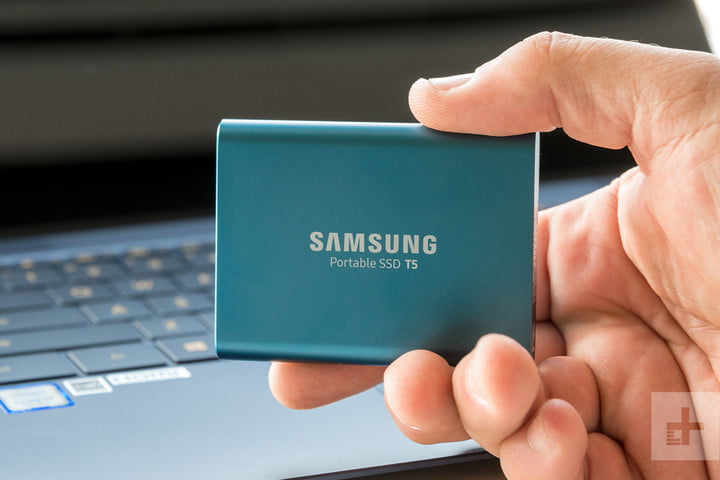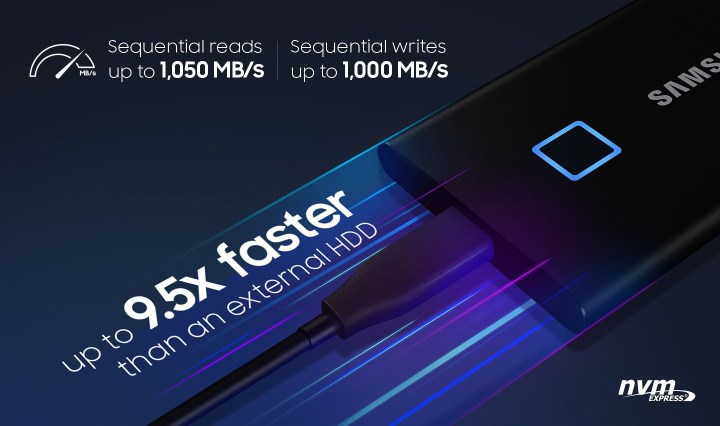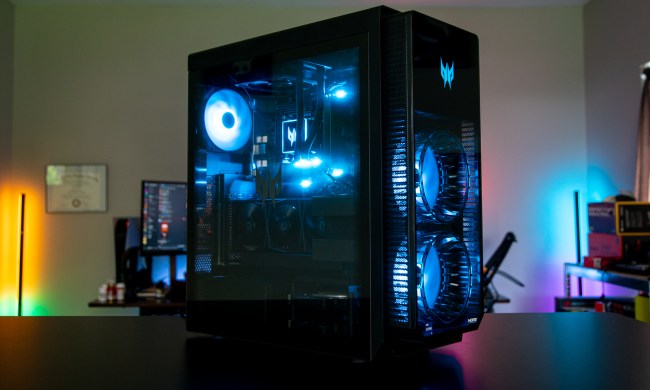Solid-state drives (SSDs) are increasingly common in portable storage, as they can be up to 10 times faster than traditional hard drives, thereby reducing boot times and offering faster data transfer rates. With no moving parts, they’re also more durable against knocks and drops. There are a number of portable SSD manufacturers, but Samsung is one of the best, and two of its best portable SSDs are the iconic Samsung T5 and the newer T7.
Both drives are very similar-looking, pocket-sized external SSDs meant for professional and casual users. While the T5 was launched in 2017, the T7 made its debut in 2020 with two variants — a standard version and a “Touch” version featuring a fingerprint reader for added security. The T7 also builds upon its predecessor by offering double the transfer speeds.
Here we have a quick comparison between the two to understand which one is better and offers the most bang for your buck.
Specifications
| Samsung T5 | Samsung T7 | |
| Transfer speeds | 540MBps | 1,050MBps |
| Capacity | 250GB, 500GB, 1TB, 2TB | 500GB, 1TB, 2TB |
| Dimensions | 2.91 x 2.25 x 0.41 inches | 3.34 x 2.24 x 0.31 inches |
| Weight | 1.79 pounds | 2.04 pounds |
| Interface | USB Type-C USB 3.1 Gen 2 (10Gbps) | USB Type-C USB 3.2 Gen 2 (10Gbps) |
| Security | Password protection, AES 256-bit encryption | Password protection, AES 256-bit encryption, Fingerprint scanner (T7 Touch) |
| Colors | Alluring Blue, Deep Black | Indigo Blue, Titan Gray, Metallic Red |
| Price | Starting at $83 | Starting at $85 |
Design and build
The T5 and T7 look and feel very similar with only a few differences. The T5 is smaller and lighter with dimensions of 2.91 x 2.25 x 0.41 inches and weighing 1.79 pounds. The T7 is slightly taller but thinner, at 3.34 x 2.24 x 0.31 inches weighing 2.04 pounds. The Touch variant of the T7 comes with a square-shaped fingerprint reader having a blue “Motion LED” to indicate the status of the drive.
The T5 and T7 are available in a few color options, too. You can get the T5 in Alluring Blue (250GB and 500GB) and Deep Black (1TB and 2TB). The T7 is available in Indigo Blue, Titan Gray, and Metallic Red (500GB, 1TB, and 2TB) while the T7 Touch is available in Black and Silver (500GB, 1TB, and 2TB).

In terms of build and construction, the T5 comes with an aluminum shell paired with plastic panels on the side, while the T7 has an all-aluminum finish. Both come with a sole USB Type-C port, and the clean design makes for an attractive package that allows one to carry it around effortlessly. I have been personally using the T5 for a few years now, and the only visible wear and tear is around the USB port. Samsung also claims that the T7 and the T5 can handle drops of up to 2 meters, and with the built-in thermal guard, one doesn’t have to worry about the drive overheating.
In short, both the T5 and T7 should easily last you for years to come.
Performance
The most obvious difference between the T5 and T7 portable SSDs is how fast they can read and write data. Samsung claims that the T7 is almost twice as fast as the older T5, capable of offering up to 1,050MBps read speeds and 1,000MBps write speeds. In real-world testing, it tends to be closer to 1,000MBps and 800MBps, which are still pretty impressive speeds. On the other hand, the T5 is capable of reaching 505MBps read and 480MBps write speeds in real-world testing.
The difference between the two drives is quite clear. The T7 is much faster and should reduce your data transfer time by almost half, making it a better option for someone who has to deal with large amounts of data like RAW images and 4K videos.

Samsung also updated the USB interface from 3.1 Gen 2 on the T5 to 3.2 Gen 2 on the T7. The latter is the newer technology here; however, both are capped at 10GBps of bandwidth, so it isn’t all that relevant. What is important to understand is that since USB technology is backward compatible, you should be able to use either of the drives with any USB Type-A port. Your mileage is going to vary depending on the interface, so we recommend using USB 3.0 or higher for the best performance output.
Security
Both portable drives offer AES 256-bit encryption, and you can password protect them using Samsung’s Magician software. But the T7 Touch comes with a built-in fingerprint scanner, making it the most secure of the lot. The best part is, once you have set your fingerprint, it works on all devices, including Android. If you have some confidential data, it is best that you invest in the T7 Touch.
Cost
The Samsung T5 was launched at a starting price of $130 for the base model that came with 250GB of storage. While that model is hard to find, you can purchase the 500GB model for about $83, 1TB for $120, and 2TB for $210.
The T7 is available at a very similar price of $85 for the base 500GB model, $115 for the 1TB model, and $260 for the 2TB model.
The T7 Touch is priced higher because of the added fingerprint scanner. The 500GB model is currently selling at $105, 1TB for $140, and 2TB for $290.
Verdict
Considering the current selling price of these two drives, we wouldn’t recommend the T5, as you can get the T7 at almost the same price. The T7 Touch is the most expensive and is recommended to buyers who are concerned about data security and cannot afford any compromises. While all three drives can be secured with a simple password, the addition of a fingerprint scanner makes the T7 the most secure option.
For a look at a number of other great portable SSDs, check out our guide to the best external drives.




